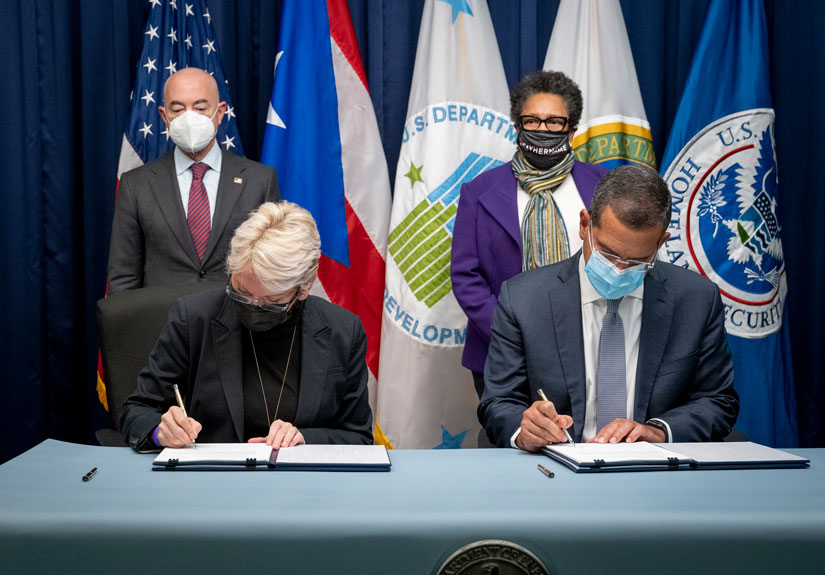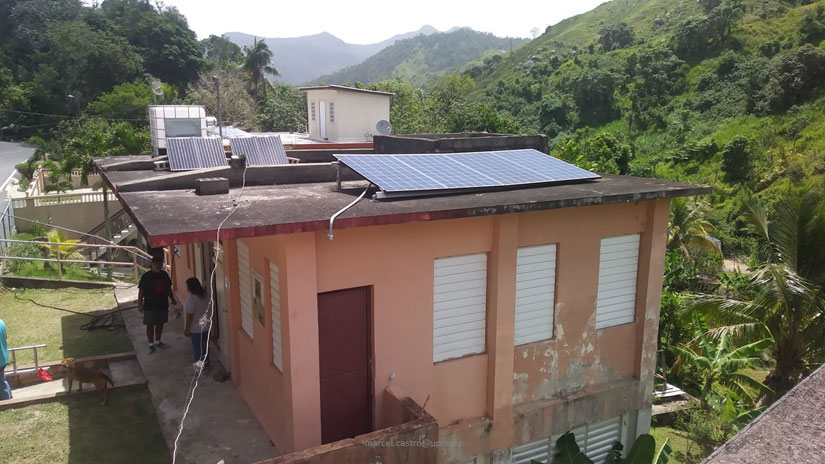DOE Launches Study To Consider Equitable Pathways To Power Puerto Rico With 100% Renewable Energy
An analysis led by the National Renewable Energy Laboratory (NREL) is now underway to supply Puerto Rico with options for achieving a renewable, reliable, and equitable electric power system.
The study, Puerto Rico Grid Resilience and Transitions to 100% Renewable Energy (PR100), will leverage the most advanced U.S. research capabilities across multiple Department of Energy (DOE) national laboratories to de-risk Puerto Rico's investments in modern, intelligent, and affordable grid infrastructure.
DOE publicly launched the study on February 16 during a webinar attended by 645 participants including industry representatives, researchers, federal and local government, and Puerto Rico residents. The event featured remarks from leadership and the researchers producing the study, who discussed the scope and benefits of the historic undertaking, as well as opportunities for engagement.
In her opening remarks, U.S. Secretary of Energy Jennifer Granholm spoke of the opportunity to build back better as DOE began the 2022 "year of implementation" in Puerto Rico. Hurricanes Irma and Maria in 2017 "laid bare the vulnerability that comes from relying on fossil fuels," Granholm said. "By installing energy sources like solar, storage, and wind, Puerto Rico can build its own energy rather than relying on expensive imports. Seizing this opportunity for cleaner energy is a no-brainer."
The launch event for the Puerto Rico Grid Resilience and Transitions to 100% Renewable Energy (PR100) study took place on Feb. 16, 2022. The 75-minute webinar includes opening remarks from leadership, a description of the study and expected its outcomes, perspectives from Puerto Rico energy sector stakeholders, and a Q&A discussion.
Puerto Rico was thrashed by back-to-back natural disasters that destroyed around 80% of the island's power distribution and transmission infrastructure. With an opportunity to rebuild differently, and cautious of future storms, Puerto Rico enacted policy to build a resilient, reliable, and robust energy system with reasonable rates for all customers—an improvement over some of the highest average electricity prices in the United States. The policy set milestones to transition Puerto Rico away from imported fossil fuel in favor of generating renewable energy with the island's own excellent supply of sun, wind, water, and other renewable resources: 100% renewable energy by 2050, 60% by 2040, and 40% by 2025. As dozens of grid modernization projects break ground this year, Puerto Rico is collecting expert insight to achieve its near- and long-term objectives.
The PR100 study, directed by DOE's Office of Electricity in partnership with the Federal Emergency Management Agency (FEMA), will establish clean energy pathways for plausible Puerto Rico trajectories through 2050. The pathways will be locally tailored and will prioritize key questions around Puerto Rico's future power grid, such as its reliability during extreme weather, its equitability for all Puerto Ricans, and its impact on local economies.
"To get to an end destination, you must first have a clear path," noted NREL Director Martin Keller in his opening remarks. "We commend our partners in PR for their vision and leadership and are confident that the PR100 study will serve as a model for other communities."
FEMA Administrator Deanne Criswell recognized the interagency partners in Washington that are supporting the government of Puerto Rico in reaching its goals through a variety of expertise and flexible funding. "FEMA's public assistance program has obligated $9.5 billion in funding for the energy sector alone. Just recently, on February 2nd, history was made when the secretaries of Energy, Homeland Security, Housing and Urban Development, and the governor of Puerto Rico signed a memorandum of understanding promising to partner in the pursuit of a resilient, sustainable, and equitable energy grid for the citizens of Puerto Rico."
DOE Secretary Jennifer Granholm and Puerto Rico Governor Pedro Pierluisi signed a
memorandum of understanding with Homeland Security Secretary Alejandro Mayorkas and
Housing and Urban Development Secretary Marcia Fudge at the Department of Energy Headquarters
in Washington, D.C., on Feb. 2, 2022. The MOU outlines accelerated work to strengthen
Puerto Rico's energy resilience and enhance initiatives for clean energy. Photo from U.S. Department of Homeland Security/Benjamin Applebaum
In the same day, NREL convened the first meeting of an advisory group composed of Puerto Rico energy system stakeholders. Representing academia, community-based and environmental organizations, federal and Puerto Rico government agencies, solar and storage developers, and professional associations, the advisory group will support DOE's portfolio of support for Puerto Rico (including the PR100 study) with ongoing feedback, guidance on local priorities, and expert perspectives. The PR100 study will take place over two years during which NREL will engage a breadth of stakeholders, perform unbiased analysis with world-class capabilities, and publish transparent data and results.
"We know that the transition to 100% renewable energy in Puerto Rico could represent lower costs, more resilient electricity, and could save thousands of lives," said advisory group member Marcel Castro-Sitiriche, an assistant professor at University of Puerto Rico, Mayagüez. He suggested modeling a pathway in the study that "includes massive deployment of rooftop solar with battery systems in at least 500,000 homes in the short term as the first no-regrets action."
While historic, the PR100 study is working off an example. NREL performed a similar analysis for Los Angeles in the LA100 study, which generated custom scenarios for the city to achieve its own 2045 clean energy goals. NREL's toolset for the two studies is essentially the same, but Puerto Rico has a different power system—it has far less renewable generation to begin with and has a far greater proportion of residential consumers than Los Angeles—and distinct objectives, focused more on resilience and flexibility to endure devastatingly powerful storms and building out capacity.
Marisol Bonnet at the Department of Energy coordinates DOE's recovery efforts in Puerto Rico. "DOE has been providing resources, technical assistance, and subject matter expertise to the government of Puerto Rico for the past several years on a variety of topics such as helping assess the damages of the hurricanes, developing tools to better understand interdependencies between the power sector and other sectors, and sizing and siting microgrids for increased resilience. Now, with PR100, we will help put Puerto Rico on a path to a more resilient, renewable energy future," she said.
"As a proud Puerto Rican, this role has been the greatest honor of my career," Bonnet added.
The study's clean energy scenarios will use curated models of Puerto Rico to simulate how such an energy transition could play out. The models are assembled and simulated with a software suite that, when brought together, can forecast energy system evolution into the far future. The study will fully support Puerto Rico's energy goals, including the Renewable Portfolio Standard established in the Energy Public Policy Act of 2019, and the right to determine its own energy future.
The tools used to assess climate risks, renewable generation opportunities, possible asset failures, and transmission and distribution resilience, will leverage the best research methodologies from NREL and the other five DOE national laboratories contributing to PR100: Argonne, Lawrence Berkeley, Oak Ridge, Pacific Northwest, and Sandia. For example, the award-winning dGen™ software simulates customer adoption of distributed energy resources like rooftop solar and distributed storage through 2050. In a preliminary study using dGen, NREL analysts found that distributed solar photovoltaics (PV) installed on all residential rooftops in Puerto Rico would generate 20 gigawatts of power, far exceeding the current capacity.

Improving resilience of energy infrastructure in the face of extreme weather is a high priority for stakeholders. "NREL had people on the ground shortly after Hurricane Maria," said researcher Nate Blair, a group manager and senior analyst specializing in distributed systems and storage. "They found one PV system was significantly damaged and the one next to it was not. Some of that has to do with ensuring installations are done with [best practices] in mind."
The study will follow five activities: Input-gathering from stakeholders and the community, data-gathering about Puerto Rico's system, scenario design, focused modeling and analysis, then reports, visualization, and outreach. Some responsibilities will be shared across national laboratories, and the research team will continually engage with community interests.
"The study will reveal insights right away, beginning with four initial scenarios by summer 2022, which will continue to be refined, reviewed, and analyzed through the end of 2023," said Murali Baggu, NREL's laboratory program manager for Grid Integration and one of the principal investigators of the PR100 study.
The PR100 study is part of DOE's broader portfolio of support for energy recovery and resilience for Puerto Rico and draws on existing research conducted and tools enhanced by the national laboratories since the 2017 hurricane season and before. Prior work includes assessing the solar resource in Puerto Rico for both utility scale and residential rooftop systems; enhancements to NREL's Engage™ modeling tool for energy planning, the System Advisor Model for financial analysis of potential systems, and the PVWatts Calculator® to estimate the performance of potential PV installations; the development of the Puerto Rico Energy Efficiency Scenario Analysis Tool; and much more.
Many efforts to improve Puerto Rico's power system are happening in parallel with the PR100 study. Among others, DOE is developing a hurricane forecasting and preparedness tool, Puerto Rico's housing authority is enhancing reliability and resilience within residential solar and energy storage installations, and the utility has begun a competitive process that will result in the procurement of thousands of megawatts of renewable resources and energy storage. The PR100 study is central to this monumental effort and will muster the best of DOE's resources to inform possibilities for Puerto Rico's investment in a clean, resilient, and affordable energy future.
NREL's ongoing and past activities to support energy planning in Puerto Rico, including publications, tools, and other resources, is available on the laboratory's Multi-Lab Energy Planning Support for Puerto Rico webpage.
Stay informed about PR100 by subscribing to email updates, including additional opportunities for public engagement
and input throughout the study.

